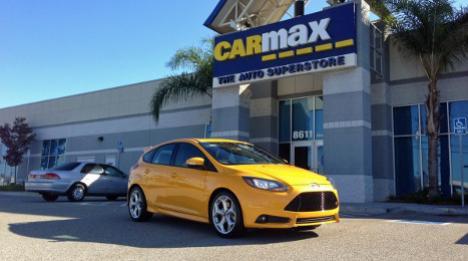If there is one statistic from Digital Air Strike’s recent study that best highlights the importance of social media in your store’s marketing efforts, it might be this one: better than nine out of every 10 buyers (91 percent) used social media/review sites in the dealership selection process.
And based on the findings illustrated throughout the 2014 Automotive Social Media Trends Study, it seems that Facebook, in particular, can be a Swiss Army knife for dealers.
Many are aware of its capabilities for consumer engagement, but Facebook can also be deployed for marketing and sales.
In fact, Digital Air Strike found that 48 percent of car buyers said they would utilize Facebook’s new “click to purchase” feature to make auto-related purchases or pick up discounts, and a third have clicked on a Facebook ad through a mobile device.
Facebook is also proving to be a fairly sharp tool for reviews, as Digital Air Strike indicated that it is now rated by car buyers as a top-five dealership review site.
“I think that, paired with the fact that (car buyers) said that Facebook reviews were the most influential — because it was from someone that they knew; potentially, from a friend — is very compelling,” Digital Air Strike chief executive officer and co-founder Alexi Venneri told Auto Remarketing in an interview.
Regarding the influence of Facebook reviews, Digital Air Strike found three-fourths of car buyers were apt to put more stock in a review from a Facebook friend than one done through another site by an unknown person.
So, when asked if she found Facebook to be better fit for shopping purposes, engagement purposes, or both, Venneri went with the latter.
“You absolutely do want to engage with existing customers on Facebook,” she continued. “But more and more we’re seeing that consumers are definitely willing and ready to use Facebook to make buying decisions and to actually now do direct purchase for things like accessories and service appointments, etc.,” Venneri said. “So it’s pretty commonplace, and they’re very open to it.”
Which begs the question, if car buyers are willing to use click-to-purchase on Facebook for items like accessories and service appoints, does that shed light on what dealers should be advertising on Facebook?
In other words, is Facebook marketing better suited to advertise service appointments and accessories versus the cars that are in a dealer’s inventory?
“Not necessarily,” Venneri said. “We actually run a number of Facebook ad campaigns for quite a few dealerships, and we test all sorts of different messages.
“What’s really nice is, I think that previously, in pretty much all other mediums, dealers would have to choose what marketing avenue they would use for different products or services,” she continued. “Really, for the first time, we can holistically market the entire dealership, because you’ve got everybody on there. You’ve got prospects — and we’ll target in-market shoppers based on Polk data around when vehicles are coming up on lease renewals.”
Additionally, Digital Air Strike can use Facebook to hone in on, for instance, certain types of vehicle enthusiasts to schedule service appointments. Or, for example, they can target customers who just bought a car, taking email addresses from dealership DMS to do custom campaigns to target them for accessories or additional purchases.
This marketing approach via Facebook is also very measurable, she added, as it’s possible to track which campaigns are generating more revenue and adjust accordingly.
“It’s literally the most measurable and the most holistic medium we’re seeing for dealers today,” Venneri said.
Key Items on Your Facebook Page
Among the reminders from Venneri of what dealers should include on their Facebook pages was something relatively simple, yet often overlooked.
In the “about” section on a dealership’s Facebook page, many stores don’t not have it set up to where the dealership’s main website URL is front-and-center and easily accessed. Often, it’s buried — and that could be doing harm to your website conversions, Venneri said.
She went on to give this tip about combining a Facebook content strategy with an ad strategy: “Some of the best ads are promoted posts.”
For instance, you might have a special event coming up at your store, or an OEM financing incentive.
Granted, that incentive might be available to all same-brand dealers in your area, “But if you’re the only dealer really talking about it, you may generate more leads just for that reason,” Venneri said.
“I definitely find that they have to have a plan to leverage content, and then also promote it. You can’t just hope that your likers are going to see your post; they just don’t show up in news feeds anymore, unless you’re actively promoting it,” she continued. “But if you’re actively promoting it with Facebook ads, you will for sure see conversions and traffic if you’re doing it the right way.”
Other Social Media Uses
Of course, Facebook isn’t the only opportunity for dealers. Digital Air Strike’s study found that review sites continue to be “the most helpful resource for car buyers.”
A fifth of car buyers called review sites the most helpful/important factor, and another 25 percent considered them to be at least as important or helpful as dealer websites.
Meanwhile, 28 percent found them to be somewhat helpful; 9 percent considered them not important; and 19 percent said they were very helpful, just not to the degree of dealer sites.
What’s more, more than four-fifths of car buyers (83 percent) checked out dealership star ratings (from review sites) in search-engine results, regardless of whether they actually went on to read the review.
Editor's Note: This story appears in the Nov. 15 print and digital editions of Auto Remarketing, which hone in on the top Used-Car Advertising Ideas for Dealers.
TransUnion acknowledged conventional wisdom suggests the summer months prior to a new school year are most popular for household moves. But a new analysis from the credit bureau found that the higher volume season actually lasts from May all the way through December.
Analysts indicated these findings may be of special benefit to skip-tracers, repossession agents, finance company executives and other collections managers who previously conducted one annual batch file update to their customers' contact information.
More frequent batch updates could result in better opportunities to reach consumers, according to TransUnion.
The TransUnion analysis verified that August, just before the new school year, is the most popular month during which moves occur (representing 10.1 percent of all household move activity).
However, TransUnion executive vice president Tim Martin pointed out that the later months of the year from September (9.6 percent) through December (8.5 percent) are all above-average months for household moves and closer to the peak in August than expected.
“Most collections agencies, financial and insurance companies know they need to update the contact information in their files at least once a year, but many assume the new school year signals a slowdown in household moves,” Martin said.
“Our analysis of consumer address changes found that consumers are constantly moving throughout the year, even in presumed lower volume months such as October, November and December,” he continued.
According to TransUnion's analysis, the lowest moving volumes occur in January, February and March, when the percent of household moves falls between 6 percent and 7.5 percent each month. The amount of household moves spikes as the year progresses into spring, hitting 8 percent by May and peaking in August.
“After the August move peak, collections agencies, financial services companies and insurance providers should strategically update their files in September to include the new address data on consumers or businesses that owe debts,” Martin said.
“However, only conducting one batch update in September would leave companies with inaccurate data for many months as consumers continue to move at year-end,” he went on to say. “We recommend another batch update late in the year, or perhaps at the beginning of the new year.”
The TransUnion analysis reviewed self-reported consumer address changes, insurance filing reports and other data from 2007 to 2014 and found consistent results for all states across the United States.
Martin reiterated TransUnion's TLOxp offers a massive data repository to locate “even the hardest to reach” individuals and businesses that owe debt.
Using the TLOxp batch processing tools, companies can reduce the time to collect and flag, scrub and merge large volumes of data to reduce the need for manual searches.
More information about TLOxp can be found at www.tlo.com.
The folks at Swapalease.com released a blog post on their site this week regarding photo-taking mishaps to avoid when selling a vehicle online. While most of these tips are aimed at private sales, these guidelines are good to keep in mind for dealer sales, as well. The following 11 suggestions from the Cincinnati-based marketplace are situations and photo-taking practices to avoid:
- Poor photo filters: Filters might be okay to use on your Instagram for your night out on the town or a trip to an exotic locale on your vacation. But for selling transparency? The clearer, the better.
- Stretched photos: Make sure the photo accurately represents the true dimensions of the car.
- Inappropriate vehicle location: A photo of your car right next to a dumpster doesn’t exactly give the right impression, does it?
- Improper photo orientation: Your cars are designed to navigate the horizontal planes of life — make sure your photos reflect that. You’re selling a car, not a rocket ship.
- Nighttime photos: Just like you try to keep your lot as well-lit during business hours as possible, customers want the same in an advertisement for the vehicle.
- Poor photo cropping: Show the whole car — having parts of the car off-frame may suggest there are parts of it you’re trying to hide.
- Sun glare photos: Once again: the clearer, the better. If you’re having trouble finding a good angle at a certain time of day, move the car to a better location, turn it around, or take the photo at a different time.
- Inappropriate vertical shots: If you’re taking a photo in a pinch while working on a tight deadline and have to use your phone, be sure to turn it sideways so the photo is a landscape, not a portrait.
- Not having interior shots: Customers want to see the inside of the car just as much as the outside.
- Modeling shots: Many customers won’t get the right impression if the camera is focused on something other than the vehicle for sale.
- Modeling the features: Customers are smart. You don’t need someone to point out the features one-by-one in the photos. If you say it has a sunroof, they’ll notice it by the simple fact it has one in the photos. No need to go any further than that.
Nearly three-fifths of car buyers turn to their mobile devices to read up on you and your fellow dealers, be it a review or a search for your store.
That’s according to the 2014 Automotive Social Media Trends Study released by Digital Air Strike at the J.D Power Marketing Roundtable on Wednesday.
“The overall trend toward the increased use of mobile technologies among consumers also holds true in this study, with 56 percent of car buyers using a mobile device to search and/or read reviews about a dealership,” the company said in a recap of its findings.
Interestingly enough, the device a consumer uses to view automotive content may depend on the time and day of the week.
Also sharing the results of a study this week at the J.D. Power event was AddThis, which said in an analysis that the “primary times that consumers engage with auto content varies by device.”
The recap of the AddThis study notes that Wednesday afternoon is prime time for using desktops to view auto content; meanwhile, they’re more apt to use tablets for auto content on Thursday evenings and mobile devices on Saturday morning.
And for dealers thinking mobile, here’s why that’s not such a bad idea:
According to comScore data cited by Contact At Once, there are 173 million smartphone owners in the U.S., which is nearly three-quarters of all mobile subscribers.
And according to eMarketer data cited in Contact at Once’s 2014 Dealer Survey Results analysis, consumers spend nearly three hours on their mobile device each day, with 43 percent never choosing to “unplug.”
What’s more, Contact At Once pointed to data from xAd-Telmetrics showing that more than a third of car-shopping research (35 percent) is conducted solely through mobile devices.
And here’s why that phone may come in handy: A Contact At Once blog post summarizing its dealer survey results shows that three-fourths of dealer respondents felt that texting a consumer for follow-up would get more response than calling.
“Society as a whole is becoming more ‘text-based’ every day, and it’s only going to increase as ‘digital native’ generations join the car-buying market,” said Contact At Once chief executive officer John Hanger.
“More than nine in 10 of our survey respondents who shared their experiences regarding millennial shoppers said they prefer chat and text,” he added.
In addition to providing details on its new location opening this month, CarMax Auctions unveiled a new logo and announced plans to thank its wholesale customers during its Customer Appreciation Month.
CarMax Auctions will be hosting catered meals and giveaways to dealers throughout the month of October. The company has over 60 auction locations, with its newest facility opening in the Portland area on Oct. 20.
Sneak-previews of vehicle inventory, including photos and free vehicle history reports, can be found on the CarMax Auctions website along with more information about the company’s customer appreciation plans.
CarMax’s Auction division has been doing business since 1996 and has sold more than 3 million vehicles on the block.
J.D. Power released the results of its recent report on customer reactions to their interactions with automotive mobile sites on Thursday. The J.D. Power 2014 Automotive Mobile Site Study found that smartphone users are more likely to share vehicle information on social media when they are satisfied with the experience they had on either a manufacturer’s or third-party’s automotive website.
In its third year, the study was redesigned to collect details on content and tool usage while measuring which content was the most effective during the vehicle-shopping process. Website usefulness was measured in four ways: information/content, navigation, appearance and speed, while calculating satisfaction on a 1,000-point scale.
While it’s probably not surprising that customers tend to share on social media their most positive experiences, several key findings were derived from the most recent iteration of the ongoing study, according to J.D Power. The company listed them as follows:
- Shoppers who share vehicle information on social media are more likely to share imagery, such as exterior images (48 percent), interior images (42 percent) and videos (40 percent) than other less visual content, such as payment/lease (18 percent) or dealer information (25 percent).
- Use of videos, interior 360-degree and exterior 360-degree tools has a significant positive impact on satisfaction among smartphone shoppers when researching how a vehicle looks on both OEM and third-party websites.
- When researching vehicle information shoppers who access an OEM website on a smartphone are much more likely to use a build and price tool (43 percent) than those who shop on third-party sites (30 percent). However, vehicle shoppers accessing a third-party website on a smartphone are more likely to use an inventory search tool (36 percent) than those on an OEM site (32 percent).
- The largest gap (90 points) in satisfaction between OEM (806) and third-party sites (716) is in appearance of the website.
“When vehicle shoppers have a positive experience on an OEM or third-party site, they are more likely to share the content they find useful or interesting with others,” said Arianne Walker, J.D. Power’s senior director of automotive media and marketing. “This provides auto brands a great opportunity to get their content out in front of consumers through social media. The challenge is not only having great content to encourage sharing, but also ensuring that consumers have an outstanding experience no matter what site they are accessing on their smartphone.”
The report also outlined several manufacturer websites that customer responses said they had the best experience viewing. Topping the list was Acura with a score of 811, followed closely by Cadillac (803), Porsche (802) and Chrysler (801).
Dealership intelligence platform provider String Automotive highlighted that the latest enhancement to its dealer positioning system (DPS) now integrates rich demographic and psychographic information drawn from Experian Automotive’s Auto Market DNA database.
String Automotive explained the dealer positioning system now can empower dealers to get a full picture of what is happening in their market at a ZIP code level. The platform can overlay numerous data sets — including Web statistics, demand and registration data — with a dealer’s own sales and inventory data to help dealers make decisions on what areas to target, which models to market and how to spend marketing dollars more effectively.
Furthermore, dealers can see the most common profiles of buyers in each ZIP code surrounding their stores, going beyond demographic data like average income and life stage to include psychographic information such as advertising receptivity, channel preference and key values.
Managers can also drill down by model to see whether people who purchase a particular vehicle tend to be “Age of Aquarius” boomers or “Urban Edge” singles; what mediums they tend to consume (such as newspaper, television or radio); whether they prefer to be approached via direct mail, email or phone; and what messages resonate most with them.
“For years, automotive dealers have had insight into what types of vehicles are being sold in their areas and some basic demographic information about the buyers. However, they’ve never been presented with actionable insights regarding the mindset and values of today’s car buying customer,” said John Gray, president of Experian Automotive.
“We’ve designed our Auto Market DNA to help fill this void by delivering unique insight into what drives and motivates car shoppers. By teaming with String Automotive, we’re able to provide their customers with a better understanding of their local markets to help them gain a competitive marketing advantage,” Gray continued.
Gray pointed out that Auto Market DNA employs a powerful research database that combines Experian’s vehicle registration data with demographic and behavioral consumer data from its ConsumerView platform. This compelling combination can enable users to not only better understand which vehicles are being purchased, but also obtain deeper insight into why customers are purchasing them.
“Access to this level of knowledge and insight into car buyers in each local market has never been available to the average dealer,” said Ken Kolodziej, String Automotive’s founder and chief executive officer.
“We’re excited to work with dealers and their advertising agencies as they translate Experian Automotive’s rich data into campaigns and offers that really resonate with individual consumers,” Kolodziej added.
Kolodziej also mentioned the Dealer Positioning System can help dealers discover which ZIP codes near their dealership represent the most opportunity to gain market share or conquest against cross-shopped makes. With the introduction of Experian Automotive data into the application, dealers and their agencies can develop highly tactical plans to attack those ZIP codes.
For example, BMW buyers in one area may prefer newspaper advertising and care deeply about a dealership’s history and reputation for service, while shoppers just a few towns over might favor Internet or TV advertising and be more receptive to financing offers and celebrity endorsements.
Ashton Brown, digital marketing director of Heritage Volkswagen of South Atlanta described what having that information can do to help a store move more metal.
"In a saturated market where it takes more than a good product to bring consumers into the dealership, combined with strict consumer protection laws in place, there is no room for error in allocating our marketing dollars,” Brown said.
“The new Experian data gives us measurements of which advertising messages and mediums can be used within a specific market, or even ZIP code, to harness the attention of potential buyers,” Brown continued.
“It also gives dealers real tangible data to review with their ad agency as to why or why not specific media buys may or may not work. We are no longer in a 'let's hope this works' era of automotive marketing,” Brown went on to say.
Kolodziej will be speaking at the 17th Digital Dealer Conference & Exposition next Wednesday in Las Vegas. The session that begins at 8:30 a.m. and is titled, “Be a Data-Driven Dealer” will focus on how to make decisions with your head not your gut, using data as the driving force.
To catch the attention of dog lovers everywhere, AutoTrader is celebrating National Dog Day by naming a list of vehicles that are most friendly toward the furrier of passengers.
AutoTrader.com released its list today of their picks for “Must-Shop Cars for Dog Lovers.”
And catering to the dog lovers in your community may bode well on the lot — according to the American Pet Products Association, over 56 million American Households own a dog.
The vehicles chosen for the list range from the outdoorsy Subaru Outback to the quirky Nissan Juke and feature dog-friendly amenities such as fold-flat seats, rear lift gate, low ride height, airy cabin and underfloor storage
Vehicles on the list also include:
- Volkswagen Tiguan
- BMW X3
- Volvo V60
- Kia Soul
- Honda Odyssey
“It’s important to take your lifestyle into consideration when choosing a car, and for many people, this includes their dog,” said Brian Moody, AutoTrader.com site editor. “Dog owners should be mindful of the features that will make traveling with their dog easier, and if possible, even take their dog with them on the test drive to make sure the car is the right fit for everyone in the family.”
In fact, in a recent survey, 55 percent of the site’s visitors polled who own a dog said they look out for cars and trucks that can accommodate their pet.
Of site visitors polled who have a dog, 75 percent take them in the car once per month or more, and 53 percent take them in the car at least once a week, site officials reported.
For more information on AutoTrader.com’s picks for more dog-friendly rides, see here.
Flick Fusion announced this week its video marketing platform for dealers, offering what it contends is the first of such platforms to automate the video production process, including inventory videos, video emails and other various dealer-related videos.
Brian Cox, the president and chief executive officer of Flick Fusion, says his company offers to dealers the digital platform for their inventory that they need to maximize sales.
“Many dealers want to incorporate video into their marketing plan, but don’t have the resources or expertise to create dynamic videos for all their marketing needs,” Cox said. “Our platform offers a simple, cost-effective method for creating a video marketing strategy proven to attract more web site visitors and convert them into leads.”
Flick Fusion utilizes the power of Google by avoiding Flash and publishing videos in “SEO-friendly” formats and uploads them to YouTube, increasing exposure to a wider market.
“Flash videos can’t be indexed by Google and therefore they don’t boost SEO rankings,” Cox said. “Additionally, many third-party sites don’t accept Flash so dealers can’t benefit from video syndication, which also boosts rankings.”
In addition to the video format, the program also utilizes VidMail, which allows dealer employees to customize videos for individual lead inquiries, which can be custom-made on request with video greetings, vehicle walkarounds and other related dealership videos.
For more information about Flick Fusion, visit their site here.
Advertising the sale or financing of motor vehicles has become increasingly complicated with an aggressive Federal Trade Commission (FTC) and the need to reach consumers (especially Millennials) through social media, which was never thought of when advertising laws and regulations were written. It certainly makes a dealer’s life more complex.
The FTC has launched a new automotive program since the Dodd-Frank Act gave it streamlined authority to write regulations. It has also become much more active in pursuing dealers for deceptive advertising under Section 5 of the FTC Act. (Since 2012, the FTC has brought 16 cases against auto dealers for deceptive advertising.) The FTC’s Head of its Bureau of Consumer Affairs said the FTC believes that deceptive dealer advertising is a “significant problem,” many automotive dealer investigations are “in the pipeline,” and that this is a “priority area” for the FTC.
The FTC’s Definition of Deception
The FTC defines “deceptive” as any representation, omission, or practice that is likely to mislead a consumer acting reasonably under the circumstances. The representation, omission, or practice must be “material” which generally means whether it is likely to affect a consumer’s conduct or decision with regard to a financial product or service, such as automotive financing. A recent FTC consent order was based on an advertisement that held in big bold print “2013 KIA Sportage. $0 down and $99 per month.” Buried in small faint-gray type with the background of a white and silver wheel were a series of disclosures that included noting that only the first two months were at $99 — with the remaining 70 monthly payments being $521. Another dealer advertised a low vehicle price but buried in the inconspicuous footnote was a $5,000 down payment requirement.
Another deceptive advertisement listed favorable financing terms for a vehicle, but failed to disclose that in order to qualify, consumers must have met numerous other criteria which few, if any, could collectively meet. This is called “rebate stacking” and the FTC considers it to be deceptive as well.
Clear and Conspicuous
Qualifications must be “clear and conspicuous” and small print type at the bottom of a page apparently doesn’t do it. Nor do disclosures on a different page in a multi-page flier from where the qualified term is advertised.
It is the overall impression of the ad that the FTC evaluates and it looks at what is not said as well as what is said. Remember, no consumer actually has to be misled by the advertisement. If the FTC determines it is “likely to mislead,” a 20-year consent decree may be in the offing as occurred with these dealers. Any violation by running another advertisement the FTC deems to be deceptive could incur penalties of up to $16,000 per piece mailed or per viewing of a printed or online advertisement.
In determining whether an advertisement is deceptive, the FTC has described the four “P”s that are necessary for dealer advertising. “Prominence” and “proximity” refer to where the qualifications are placed in type size, visibility, and location relative to the qualified term. “Placement” is whether the language is located in a place where the reasonable consumer is likely to notice and comprehend it.
Finally, “presentation” refers to whether or not the wording is clear and simple enough to be understood by a reasonable consumer. When the FTC audits a dealer, it will look at sales training material to ascertain what type of language and statements your sales people are trained to make to a consumer as well. The FTC has said that all sums to be paid must be disclosed in the advertisement, except that a dealer can say generally that tax, tags and title fees are additional. Again, all statements must be clear and conspicuous.
The FTC has stated that the following phrases are acceptable: “No down payment” (however this phrase triggers other required disclosures under Federal Truth in Lending as discussed in the next paragraph); “easy monthly payments;” “low down payments;” and “terms to fit your budget.”
Additional Violations
When the FTC comes upon what it believes to be a deceptive advertisement, it doesn’t stop there. It looks for other violations in both advertising and in your dealership. A failure to disclose Truth in Lending (Regulation Z) or Consumer Leasing Act (Regulation M) triggered terms is an example of an additional advertising violation.
For credit sales, if you disclose the down payment, payment amount, or period of repayment, then you must also disclose the APR (stated as such), the down payment, the amount of each payment, and the payment term.
For consumer leasing, if you advertise the amount of any up-front payment or cap cost reduction, you must also advertise that it is a lease, the total amount due at lease signing, the number and amount of scheduled payments, whether a security deposit is required, and any back-end liability such as for an open-end lease.
With the FTC also focused actively on privacy and Safeguards, an audit of your dealership for prospective deceptive advertising may also uncover violations of these rules or other FTC rules such as the Red Flags Rule concerning verifying customer identity. The FTC argues these violations create “unfair practice” liability under Section 5 of the FTC Act.
An unfair act or practice is one that causes or is likely to cause substantial injury to consumers; the injury cannot reasonably be avoided by consumers; and such substantial injury is not outweighed by benefits to consumers or to competition. So, for example, if your privacy notice says that you do not share customer non-public personal information and your DMS provider extracts customer data and uses it for its own purposes (e.g., to create leads or prospect lists), you may be liable under Section 5 for a deceptive and unfair practice for violating your privacy notice.
Penalties for deceptive or unfair practices can range from a 20-year consent decree to a penalty of up to $16,000 per violation, which each advertising piece, each Internet view, and every privacy notice or Safeguards violation being considered a separate violation.
Among other things, the FTC indicated it is actively auditing dealers for Red Flags compliance, Safeguards compliance, payment packing (adding optional aftermarket products such as credit life or an extended service contract to the cost of the vehicle), “yo-yo” financing (spot delivery deals), rebate stacking, and buy rate markups. It recently penalized a dealer for not placing “Used Car Buyers Guides” on used cars in its sales lot. It held hearings on these and other subjects in 2011, and may be ready to write rules or bring more enforcement actions on any of these issues as well.
Social Media Challenges
Internet or social media advertising presents its own set of challenges in addition to possibly being deceptive. All disclosures that need to be made clearly and conspicuously in print must also be made clearly and conspicuously online, regardless of media. (How a 140-character Tweet advertisement can include required disclosures is a mystery). In assessing penalties for deceptive Internet or social media advertisements, the FTC has said the same standards for deceptive and unfair advertising apply.
Another problem with Internet advertising arises if you desire to change any element of the advertisement. Internet copy has permanence and lawsuits have been brought against dealers whose Web advertisements were changed or picked up by different sites, possibly without the dealer even knowing so. When the dealer removed or changed the advertisement, the prior advertisement was still picked up by consumers from the other sites and the dealer was accused of advertising terms that were not actually available, which also violates Truth in Lending.
A good practice is to put an expiration date on your Internet advertisements so there is no confusion. Try not to have to change the pricing or other terms for a vehicle posted online.
The FTC has indicated its continuing intention to police dealer advertising as well as other dealer acts under its newfound streamlined Dodd-Frank Act authority. Expect more enforcement actions and possibly a set of rules on issues like spot deals, online tracking, and aftermarket product selling.
It has become a far more activist agency since the arrival of the Consumer Financial Protection Bureau and it would appear that each agency is taking a very aggressive, pro-consumer stand.
And don’t forget that Attorneys General have broader authority under the Dodd-Frank Act to enforce federal as well as state consumer protection laws as well. Enhance your compliance efforts accordingly.
Randy Henrick is associate general counsel, regulatory and compliance, for Dealertrack. This blog post and more can be found here.












